
Fra Angelico was an Italian painter of the Early Renaissance, described by Vasari in his Lives of the Artists as having "a rare and perfect talent". He earned his reputation primarily for the series of frescoes he made for his own friary, San Marco, in Florence.
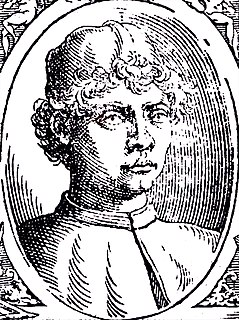
Piero della Francesca, originally named Piero di Benedetto, was an Italian painter of the Early Renaissance. To contemporaries he was also known as a mathematician and geometer. Nowadays Piero della Francesca is chiefly appreciated for his art. His painting is characterized by its serene humanism, its use of geometric forms and perspective. His most famous work is the cycle of frescoes The History of the True Cross in the church of San Francesco in the Tuscan town of Arezzo.

Palazzo Farnese or Farnese Palace is one of the most important High Renaissance palaces in Rome. Owned by the Italian Republic, it was given to the French government in 1936 for a period of 99 years, and currently serves as the French embassy in Italy.

Il Sodoma was the name given to the Italian Renaissance painter Giovanni Antonio Bazzi. Il Sodoma painted in a manner that superimposed the High Renaissance style of early 16th-century Rome onto the traditions of the provincial Sienese school; he spent the bulk of his professional life in Siena, with two periods in Rome.

Jacopo Ligozzi (1547–1627) was an Italian painter, illustrator, designer, and miniaturist. His art can be categorized as late-Renaissance and Mannerist styles.

Daniele Ricciarelli, better known as Daniele da Volterra, was a Mannerist Italian painter and sculptor.

Santa Maria in Vallicella, also called Chiesa Nuova, is a church in Rome, Italy, which today faces onto the main thoroughfare of the Corso Vittorio Emanuele and the corner of Via della Chiesa Nuova. It is the principal church of the Oratorians, a religious congregation of secular priests, founded by St Philip Neri in 1561 at a time in the 16th century when the Counter Reformation saw the emergence of a number of new religious organisations such as the Society of Jesus (Jesuits), the Theatines and the Barnabites.

Jacopino del Conte (1510–1598) was an Italian Mannerist painter, active in both Rome and Florence.
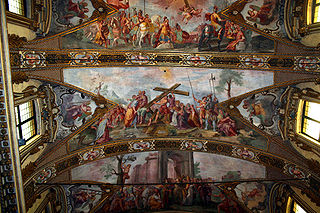
Giovanni Battista Carlone (1603–1684) was an Italian painter of the Baroque period, active mainly in Genoa.

Giuseppe Palmieri was an Italian painter of the late Baroque period.

Lorenzo Leonbruno, also known as Lorenzo de Leombeni, was an Italian painter during the early Renaissance period. He was born in Mantua (Mantova), an Italian commune in Lombardy, Italy. Leonbruno is most well known for being commissioned by the court of Francesco Gonzaga, Marquis of Mantua, and his wife Isabella d'Este. The patronage continued with their eldest son Federico II Gonzaga, who was the fifth Marquis of Mantua. Leonbruno was the court painter for the Gonzaga family from 1506–24.

The Basilica of Saints John and Paul on the Caelian Hill is an ancient basilica church in Rome, located on the Caelian Hill. It was originally built in 398.

The art collections of Fondazione Cariplo are a gallery of artworks with a significant historical and artistic value owned by Fondazione Cariplo in Italy. It consists of 767 paintings, 116 sculptures, 51 objects and furnishings dating from the 1st century to the second half of the 20th century.

Volterra Cathedral is a Roman Catholic cathedral in Volterra, Italy, dedicated to the Assumption of the Virgin Mary. It is the seat of the bishop of Volterra.
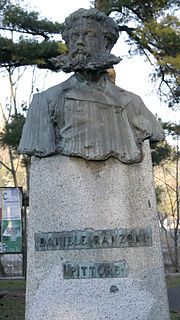
Daniele Ranzoni was an Italian painter of second half of the 19th century.
Daniele de Strobel was an Italian painter, mostly known for his fresco work in Parma and Piacenza.

Elijah in the Desert is a 1543-1547 oil on panel painting by Daniele da Volterra. With Massacre of the Innocents and Madonna and Child with the Infant St John the Baptist and Saint Barbara, it is one of a number of paintings by the artist now in the Uffizi Gallery in Florence.
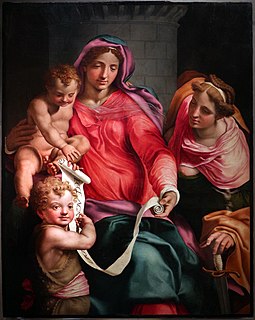
Madonna and Child with the Infant St John the Baptist and Saint Barbara is a 1548 oil on panel painting by Daniele da Volterra, now in the Uffizi, in Florence.

Madonna and Child with Saints is a 1588 oil on canvas painting by Annibale Carracci, now in the Gemäldegalerie Alte Meister in Dresden. Signed and dated by the artist, it is also known as Madonna and Child with Saints Francis, Matthew and John the Baptist, Madonna and Child Enthroned with Saint Matthew and the St Matthew Madonna.
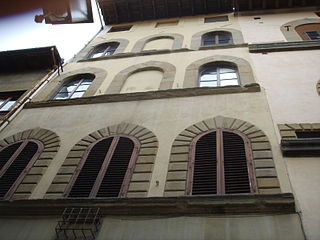
The Casa Vasari is a building at 8 borgo Santa Croce in Florence, previously the residence in that city of the painter, art historian and architect Giorgio Vasari. It preserves a valuable cycle of frescoes in the hall, conceived and created by Vasari with the help of pupils.



















